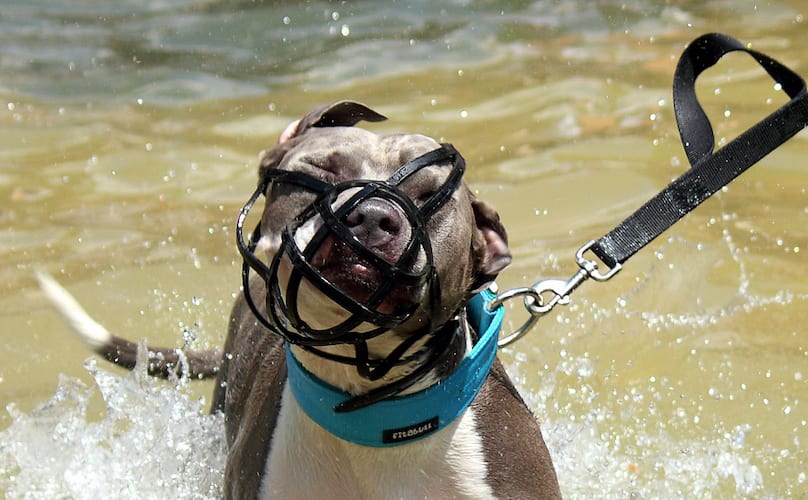***Looking for a gift to reward your dog during the muzzle-training process? Spoil them with a BarkBox! Every month BarkBox delivers 2 original toys, designed in-house, 2 full bags of all-natural treats, and a chew. Sign up here and receive a free extra toy every month. <– This deal is worth up to $120 in value if you sign up for a 12-month subscription! 🙂
Muzzling a dog can be a difficult choice for dog owners to make. Some worry about making their dog feel uncomfortable, appearing cruel, or making their dogs look like “bad dogs.”
First of all, there’s nothing wrong with dogs wearing muzzles, and wearing one does not make your dog bad. Period.
At the end of the day, it’s a personal decision based on a variety of circumstances (heck, it’s a good idea for all dogs to learn wear one just in case they’re necessary) and one that can be extremely beneficial for your canine companion.
Here are some things to consider when you’re thinking about muzzling your dog:
When To Use A Muzzle
If you’re considering muzzling your dog, you may already be having issues with them. Still, muzzling a dog is most appropriate in a few situations, rather than all. And if you’re concerned about using a muzzle, remember that your dog won’t have to wear it all the time or through the course of their life. Rather, you can use a muzzle in specific situations where your dog or the creatures around them may be put at risk.
If your dog is prone to biting, growling, or intimidating other dogs while on a walk, utilizing a muzzle may be a good idea for your daily walks if you tend to encounter other people and pets and have noticed reactive behavior. It’s stressful for your dog, dogs and humans around them, and can be stressful for you as you worry whether your dog will hurt someone. For some dogs, coming across other dogs or humans on daily walks isn’t a major point of stress, especially as they get used to their daily route and know they’re in a safe environment.
Some of these dogs may still be prone to biting or other reactive behavior in different environments, such as during trips to the vet, grooming sessions or in stressful, crowded places with lots of stimulation. Some of these places include dog parks, crowded streets and social gatherings. It may be a good idea to work toward training your dog so some of these situations are more comfortable for them, but in the meanwhile, it’s probably best to leave your pooch at home to avoid particularly high-stress situations that put your dog, other dogs and humans at risk. In particular, definitely avoid the dog park and keep them on a leash until the problems have been resolved.
When NOT To Use A Muzzle
Muzzles can keep animals and humans safe, but they’re not for every dog. As laid out above, if your dog bites and shows reactivity toward dogs and humans, muzzling may be a good idea. On the other hand, you shouldn’t use a muzzle for dogs as punishment for behavioral problems that don’t include biting.
For example, there’s no need to muzzle a dog that barks excessively or chews up your shoes at home, or pulls on their leash during walks. Those are inconveniences for you, but not reactive behavior that warrants using a muzzle. Instead, think through why your dog may be engaging in these behaviors. Is it separation anxiety, especially during the early weeks and months after you’ve taken your dog home? Do they need more attention? Are they bored and so turn to chewing up the coffee table? Are they feeling overly territorial and so bark at every new guest that enters your home?
These dogs are safer to socialize than those with biting issues, and because socializing is vital to training a dog, you should make this a priority as you ease your dog into everyday life.
If you’re having trouble training your dog on your own, don’t be afraid to turn toward a professional dog trainer or behaviorist. Look around in your area to see whether there are classes available for dog owners who want to successfully train their dogs, because turning toward a muzzle should be reserved for dogs with biting problems, not other behavioral issues.
Evaluating Your Personal Situation


On their face, muzzles may appear harsh, but there’s nothing wrong with them at all. In fact, they may relieve stress for you – and your dog! – and act as a useful training tool while you’re working on reactive biting and intimidating behavior.
If you’re encountering reactive biting behavior, make safety your top priority, and know that what you’re doing may be best for you, your dog and your community of other animals and humans.
Looking For More Articles About Training?
Why Should I Muzzle Train My Dog Even If They’re Not Reactive?
Puppy 101: How Do I Stop My Puppy From Biting?
My Dog Is Biting: How Do I Get Them To Stop?
6 Warning Signs A Dog’s About To Bite
How Do I Find A Trainer For My Dog?
Featured image via Andrey/Flickr






